
Greenock Sheriff Court is a judicial building on Nelson Street in Greenock in Scotland. The structure, which continues to operate as a courthouse, is a Category B listed building.

The Municipal Buildings are based on the north side of Buccleuch Street, Dumfries, Dumfries and Galloway, Scotland. The structure, which was the headquarters of Dumfries Burgh Council, is a Category C listed building.

The Municipal Buildings are based in Buccleuch Street in Dalkeith, Scotland. The structure, which served as the meeting place of Dalkeith Burgh Council, is a Category B listed building.

County Buildings is a municipal structure in King Erik Street, Lerwick, Shetland, Scotland. The structure, which is used as a judicial complex, is a Category B listed building.

The Midsteeple is a municipal building in the High Street in Dumfries, Dumfries and Galloway, Scotland. The structure, which is used as a ticket office and a meeting place, is a Category A listed building.
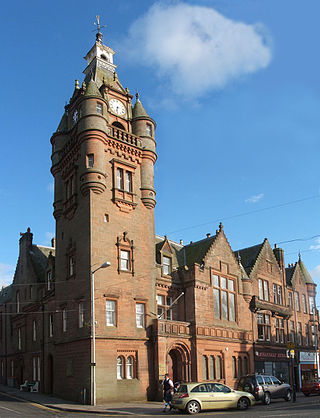
Lockerbie Town Hall is a municipal building in the High Street in Lockerbie, Dumfries and Galloway, Scotland. The structure, which is used as a venue for the provision of local services, is a Category A listed building.

County Buildings is a municipal building in Kirkcudbright, in the Dumfries and Galloway council area in Scotland. It was originally two houses on High Street, which then served as the main offices of Kirkcudbrightshire County Council from 1925 to 1975. A large extension to the rear was added in 1952, accessed from Daar Road. From 1975 until 1996 the building served as the offices of Stewartry District Council. Since 1996, it has been an area office of Dumfries and Galloway Council. It is a Category B listed building. Prior to the 1952 extension the name "County Buildings" was used for a different building, at 85 High Street, which was also the town's sheriff court.
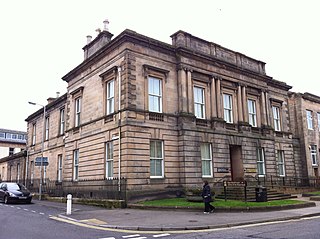
Elgin Sheriff Court is a courthouse in the High Street, Elgin, Moray, Scotland. The structure is a Category B listed building.
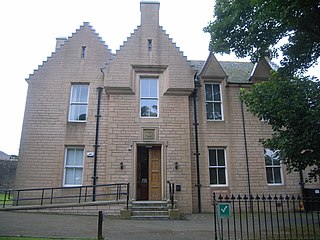
Kirkwall Sheriff Court is a judicial structure in Watergate, Kirkwall, Orkney, Scotland. The structure, which was the headquarters of Orkney County Council and is currently used as a courthouse, is a Category C listed building.

County Buildings is a municipal structure in Drysdale Street, Alloa, Clackmannanshire, Scotland. The structure, which was the headquarters of Clackmannanshire County Council and is currently used as courthouse, is a Category B listed building.

Wick Sheriff Court is a judicial structure in Bridge Street, Wick, Caithness, Scotland. The structure, which remains in use as a courthouse, is a Category B listed building.

Stranraer Sheriff Court is a judicial building in Lewis Street, Stranraer, Dumfries and Galloway, Scotland. The building, which continues to be used as a courthouse, is a Category B listed building.

Hamilton Sheriff Court is a judicial building in Almada Street, Hamilton, South Lanarkshire, Scotland. The building, which continues to serve as the local courthouse, is a Category A listed building.
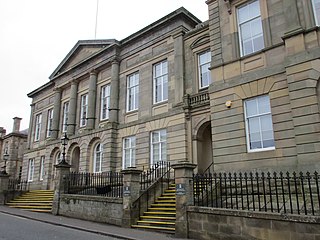
Lanark Sheriff Court is a judicial building in Hope Street, Lanark, South Lanarkshire, Scotland. The building, which continues to serve as the local courthouse, is a Category B listed building.
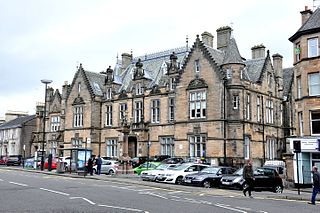
Stirling Sheriff Court is a judicial building in Viewfield Place, Barnton Street, Stirling, Scotland. The building, which remains in use as a courthouse, is a Category B listed building.

The Corn Exchange is a commercial building in Court Street, Haddington, East Lothian, Scotland. The structure, which is now used as a community events venue, is a Category B listed building.

The Old Town Hall is a former municipal building on Victoria Street in Newton Stewart, Scotland. The building, which was previously the meeting place of the burgh council, is a Category B listed building.

The Old Sheriff Court is a judicial building on Hope Street in Falkirk in Scotland. The building, which currently accommodates a firm of funeral directors, is a Category B listed building.

Dundee Sheriff Court is a judicial building on West Bell Street in Dundee in Scotland. The building, which operates as the main courthouse for the area, is a Category B listed building.

The Old Sheriff Court is a judicial building on St Marnock Street in Kilmarnock in Scotland. The building, which currently accommodates the procurator fiscal's office, is a Category B listed building.





















